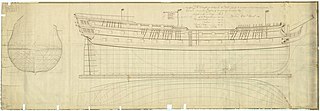Related Research Articles

HMS Colossus was a 74-gun third-rate ship of the line of the Royal Navy. She was launched at Gravesend on 4 April 1787 and lost on 10 December 1798. During her years of service she participated in the Battle of Groix, the Battle of Cape St Vincent, and the Battle of the Nile. While carrying wounded from the latter, she was wrecked at the Isles of Scilly. The wreck is a Protected Wreck managed by Historic England.

Invincible was originally a 74-gun ship of the line of the French Navy launched in October 1744. Captured on 14 May 1747, she was taken into Royal Navy service as the third rate HMS Invincible. She was wrecked in 1758 after hitting a sandbank. The wreck is a Protected Wreck managed by Historic England.

Association was a 90-gun second-rate ship of the line of the Royal Navy, launched at Portsmouth Dockyard in 1697. She served with distinction at the capture of Gibraltar, and was lost in 1707 by grounding on the Isles of Scilly in the greatest maritime disaster of the age. The wreck is a Protected Wreck managed by Historic England.

The Nautical Archaeology Society (NAS) is a charity registered in England and Wales and in Scotland and is a company limited by guarantee.

The Protection of Wrecks Act 1973 is an Act of the Parliament of the United Kingdom which provides protection for designated shipwrecks.

The Protection of Military Remains Act 1986 is an Act of Parliament in the United Kingdom which provides protection for the wreckage of military aircraft and designated military vessels. The Act provides for two types of protection: protected places and controlled sites. Military aircraft are automatically protected but vessels have to be specifically designated. The primary reason for designation is to protect as a 'war grave' the last resting place of British servicemen ; however, the Act does not require the loss of the vessel to have occurred during war.

Mensun Bound is a British maritime archaeologist born in Stanley, Falkland Islands. He is best known for directing the excavation of the Etruscan 6th-century BC shipwreck off Giglio Island, Italy, the oldest known shipwreck of the Archaic era, and the Hoi An Cargo which revolutionized the understanding of Ming-Vietnamese porcelain from Vietnam's art-historical Golden Age.
Cattewater Wreck is a wooden three-masted, skeleton-built vessel, one of many ships that have wrecked in Cattewater, Plymouth Sound, England. This wreck is close to the entrance of Sutton Harbour, its name is still unknown but it is believed to be from the 16th Century. It is a Protected Wreck managed by Historic England.

The Archaeology Discover Centre was a museum located in Fort Victoria on the Isle of Wight, England.
The Mary Rose Trust is a limited charitable trust based in Portsmouth in the United Kingdom. Its primary aims are to preserve, display and spread knowledge about the 16th century warship Mary Rose which sank in the Solent on 19 July 1545 and was salvaged by the Trust in October 1982.
The Swash Channel Wreck is the remains of an early 17th-century armed merchantman possibly of Dutch origin wrecked outside of Poole Harbour. The vessel was approximately 40 m long and has been predicted to be around 600 tonnes. The ship was probably involved with the beginning of internationalization.
Site Recorder is a geographical information system (GIS) and information management system (IMS) designed for use in maritime, freshwater and intertidal archaeology. Site Recorder can be used on maritime and intertidal archaeology projects for real-time data collection, decision support, publication, archiving and data migration. The program is designed for use by archaeologists rather than GIS experts.
HMS Brazen was the French privateer Invincible General Bonaparte, which the British captured in 1798. She is best known for her wreck in January 1800 in which all but one of her crew drowned.
The Maritime Archaeology Trust is a charitable trust that researches and excavates maritime archaeology and heritage in Great Britain. Historically, their core activities were focused around Hampshire, the Isle of Wight and the Solent, but now they work in other parts of the country and on international projects.

The Historic Shipwrecks Act 1976 was an Australian Act of Parliament designed to legally protect historic shipwrecks and any relics or artefacts from those wrecks. The Act automatically affects all shipwrecks that meet the "historic" criteria and are in Australian Commonwealth waters : complementary state and territory legislation protects shipwrecks in state and territory waters including rivers and bays. Of the estimated 8,000 shipwrecks in Australian waters, more than 6,500 are protected under this legislation.
David Moore is an American archaeologist and historian. He is best known for his work on the Blackbeard's Queen Anne's Revenge Shipwreck Project. The Queen Anne's Revenge was the flagship of the infamous pirate Blackbeard. He used her for less than a year, but she was an effective tool in his prize-taking.

Innes McCartney is a British nautical archaeologist and historian and a Research Fellow at Bournemouth University.
The Society for Underwater Historical Research (SUHR) was an amateur maritime archaeology organisation operating in South Australia (SA). It was formed in 1974 by recreational scuba divers and other persons to pursue an interest in maritime archaeology and maritime history. The SUHR was renamed as the South Australian Archaeology Society in March 2012 as part of a plan to expand its activities beyond maritime archaeology to include other archaeological disciplines.
Save Ontario Shipwrecks (SOS) is a Provincial Heritage Organization in Ontario, Canada. SOS is a public charitable organization which operates through Local Chapter Committees supported by a Provincial Board of Directors and Provincial Executive.
References
- ↑ "Maritime Archaeology Sea Trust". Thisismast.org. Retrieved 2 January 2014.
- ↑ "North and South Sands canoe trail, Salcombe". National Trust. Archived from the original on 2 January 2014. Retrieved 2 January 2014.
- ↑ "Accredited Non-Governmental Organisations". UNESCO. 2015. Retrieved 20 September 2016.
- ↑ "The Armed Forces Corporate Covenant" (PDF). Ministry of Defence. 2016. Retrieved 20 September 2016.
- ↑ "LIBOR fines to be used to support military charities and Royal Voluntary Service". HM Treasury. 12 July 2016.
- ↑ "Command of the Oceans".
- ↑ Mearns, David; Parham, Dave; Frolich, Bruno (14 March 2016). "A Portuguese East Indiaman from the 1502–1503 Fleet of Vasco da Gama off Al Hallaniyah Island, Oman: an interim report" (PDF). International Journal of Nautical Archaeology. 46 (2): 331–350. doi: 10.1111/1095-9270.12175 .
- ↑ "Vasco da Gama shipwreck history following find of Esmeralda Shipwreck off Oman coast".
- ↑ "Research guide B3: The Royal Navy: Sources for enquiries". 11 June 2002.
- ↑ "Heritage for Peace Education Initiative | United Nations Educational, Scientific and Cultural Organization". www.unesco.org. Archived from the original on 22 May 2016.
- ↑ "Archived copy" (PDF). Archived from the original (PDF) on 4 February 2013. Retrieved 7 October 2013.
{{cite web}}: CS1 maint: archived copy as title (link) - ↑ "Archived copy" (PDF). Archived from the original (PDF) on 10 June 2015. Retrieved 7 October 2013.
{{cite web}}: CS1 maint: archived copy as title (link) - ↑ "Shipwreck offers unique opportunity for study". Northumberland Gazette. 5 October 2013. Retrieved 2 January 2014.
- ↑ "Maritime Archaeology Sea Trust : Swash Channel Wreck Artefacts". Thisismast.org. Retrieved 2 January 2014.
- ↑ "UK Minister For Culture Ed Vaizey Visits The York Archaeology Trust To View Marine Artefacts | Scubaverse | The World's Best Online Dive Companion". Scubaverse. 20 September 2013. Archived from the original on 2 January 2014. Retrieved 2 January 2014.
- ↑ "BBC News - Poole Swash Channel Wreck: Raising the rudder". BBC News. Bbc.co.uk. 19 August 2013. Retrieved 2 January 2014.
- ↑ "MoD wrecks". Thisismast.org. Retrieved 2 January 2014.
- ↑ "Plymouth RNLI receives £1,000 donation". Rnli.org. Retrieved 2 January 2014.
- ↑ Herald, Plymouth (17 August 2013). "Divers delving deep to help injured heroes". Plymouth Herald. Retrieved 2 January 2014.
- ↑ Dive Training (5 August 2013). "An Introduction to the PADI Distinctive Specialty B.A.D. (Basic Archaeological Diver) | Scubaverse | The World's Best Online Dive Companion". Scubaverse. Archived from the original on 2 January 2014. Retrieved 2 January 2014.